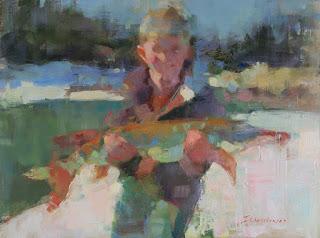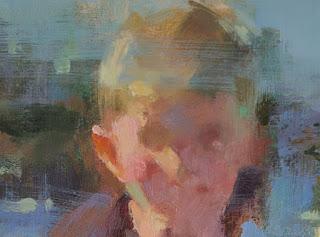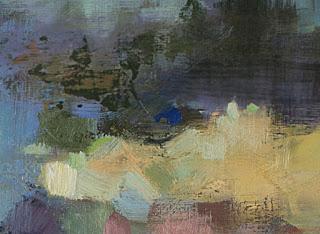
Pike
18 x24" oil on birch

detail 1

detail 2
Finally, after years of trying and failing miserably, I've figured out how to paint on panels. This is big news in my studio!
Smooth, rigid supports like wood and metal have defeated me in the past because I struggled to work in an alla prima fashion on them. Getting past that first, scruffy, scratchy layer was a trial as my hog bristle brushes tended to remove more paint than they deposited. I also found it hard to make the large variety of edges that I could on oil primed linen.
Things I tried in order to make wood work for me:
- adding alkyd mediums to the paint (often too smelly and/or toxic and/or slippery)
- switching to soft or synthetic brushes (changed the consistency and amount of paint in each stroke)
- and thickening and drying the paint slightly by squeezing it out onto cardboard overnight (helpful, but too thick and dry for first layers).
I'd almost decided to give up on the idea of rigid supports, but, since my oil primed linen comes to me from US suppliers, and the exchange rate for our Canadian dollar is abysmal, I was motivated to give it another go recently.
This time, it's working, and it comes down to changing the one thing I didn't try in the past: the way that I work. Over time, I've become a slower, more patient painter - willing to let layers dry between painting sessions - and that change in working method has, finally, allowed me to enjoy working on smooth supports. In fact, I've discovered that there are more possible textural effects available to me on wood than there are on fabric.
The images above show the complex textural surface of "Pike", done in many layers, and using my usual medium of 50/50 oil and OMS in the first layer, and then either straight paint, or paint with a bit of linseed oil. Because I use OMS sparingly and only in the first layer, and I don't clean my brushes during the working day, this limits the amount of toxic fumes in my studio (and odourless mineral spirits are toxic despite the name). The rigid surface means that I can pile on the paint without the worry of future cracking that is a drawback of flexible supports.
I've learned to never say never when it comes to painting, and I'm glad that I persevered in this.
Happy painting!

